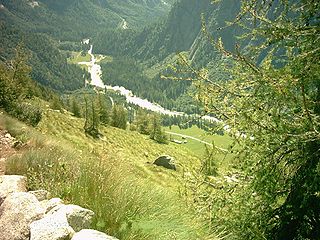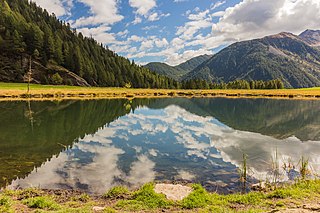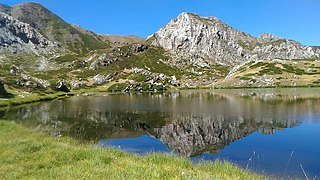
The Dolomites, also known as the Dolomite Mountains, Dolomite Alps or Dolomitic Alps, are a mountain range in northeastern Italy. They form part of the Southern Limestone Alps and extend from the River Adige in the west to the Piave Valley in the east. The northern and southern borders are defined by the Puster Valley and the Sugana Valley. The Dolomites are in the regions of Veneto, Trentino-Alto Adige/Südtirol and Friuli-Venezia Giulia, covering an area shared between the provinces of Belluno, Vicenza, Verona, Trentino, South Tyrol, Udine and Pordenone.

The province of Brescia is a province in the Lombardy region of Italy. It has a population of some 1,265,964 and its capital is the city of Brescia.

The Brenta Group or Brenta Dolomites is a mountain range, and a subrange of the Rhaetian Alps in the Southern Limestone Alps mountain group. They are located in the Province of Trentino, in northeastern Italy. It is the only dolomitic group west of the Adige River. Therefore, geographically, they have not always been considered a part of the Dolomites mountain ranges. Geologically, however, they definitely are - and therefore sometimes called the "Western Dolomites". As part of the Dolomites, the Brenta Group has been officially recognized as UNESCO World Heritage Site under the World Heritage Convention.

Saint Romedius. Though the son of a nobleman, as a young man he withdrew to a rock cave in order to meditate. After the death of his parents, he gave away all of his possessions and established himself in the Val di Non in Trentino.

Val Camonica or Valcamonica, also Valle Camonica and anglicized as Camonica Valley, is one of the largest valleys of the central Alps, in eastern Lombardy, Italy. It extends about 90 kilometres (56 mi) from the Tonale Pass to Corna Trentapassi, in the commune of Pisogne near Lake Iseo. It has an area of about 1,335 km2 (515 sq mi) and 118,323 inhabitants. The River Oglio runs through its full length, rising at Ponte di Legno and flowing into Lake Iseo between Pisogne and Costa Volpino.

The Sarca is a river springing from the Adamello-Presanella mountains in the Italian Alps and flowing into Lake Garda at Torbole. As an emissary of the lake it becomes known as the Mincio river, forming a single river system 203 kilometres (126 mi) long (Sarca-Mincio).

The Sole Valley is a valley in Trentino, northern Italy.

Molveno is a comune (municipality) in Trentino in the northern Italian region of Trentino-Alto Adige/Südtirol, located about 40 kilometres (25 mi) northwest of Trento. It is famous for its positioning on Lake Molveno as a holiday destination, its nearby ski resorts (Andalo-Paganella) and its connection to the National Park Adamello Brenta.

The Caffaro is a 25 km river of northern Italy whose course lies within the Province of Brescia, sometimes forming the border with Trentino. It belongs to the basin of Lago d'Idro.

The Chiese, also known in the Province of Brescia as the Clisi, is a 160-kilometre (99 mi) Italian river that is the principal immisary and sole emissary of the sub-alpine lake Lago d’Idro, and is a left tributary of the Oglio.

Stelvio National Park is a national park in northeast Italy, established in 1935.
The European Geoparks Network (EGN) functions as the regional organization of the Global Geoparks Network (GGN) and the UNESCO International Geosciences and Geoparks Programme (UNESCO-IGGP). Its main objective is to ensure cooperation between geoparks for the protection of geological heritage and the promotion of sustainable development of their territories in Europe. In 2020 January, the EGN had 75 institutional members from 26 European countries and there are several aspiring geopark projects, applying for a UNESCO label and therefore the permanent EGN membership.

The Madonie Regional Natural Park is an Italian regional park located in Sicily, between Palermo and Cefalù and covers 39,972 acres.

The Southern Rhaetian Alps are a mountain range in the southern part of the Alps.

The Natural Park of Marguareis(in Italian Parco Naturale del Marguareis) is a regional natural park of the Ligurian Alps located in the Province of Cuneo.

The Adamello Regional Park is a nature reserve in Lombardy, Italy. Established in 1983, it encompasses the Lombard portion of the Adamello-Presanella Alps; together with the adjacent Stelvio National Park, Swiss National Park and Adamello Brenta Natural Park, it forms the largest protected area in the Alps, nearly 400,000 hectares.

The Friulian Dolomites, also known as Dolomiti d'Oltre Piave are a mountain range in the Carnic and Gailtal Alps. They are located in northeastern Veneto and Friuli-Venezia Giulia, in northeastern Italy. They are the easternmost dolomitic group. As part of the Dolomites, they have been officially recognized as UNESCO World Heritage Site under the World Heritage Convention, and most of their area is also covered by the Friulian Dolomites Natural Park.

The Paneveggio-Pale di San Martino Natural Park is a nature reserve in Trentino, Italy. Established in 1967, it stretches over nearly 20,000 ha in the Dolomites, encompassing the Pale di San Martino massif, the Paneveggio forest, and the easternmost part of the Lagorai range, between the valleys of Fiemme, Fassa, Primiero, and Vanoi.

The Ampezzo Dolomites Natural Park is a nature reserve in Veneto, Italy. Established in 1990, it is entirely located in the territory of Cortina d’Ampezzo, in the Province of Belluno, and encompasses some of the most famous Dolomitic groups, such as the Tofane, Monte Cristallo, the Croda Rossa d'Ampezzo, Lagazuoi, Pomagagnon and Col Bechei. Together with the adjacent Naturpark Fanes-Sennes-Prags in the Province of Bolzano, it forms a protected area of 37,000 hectares in the heart of the Dolomites. The park has been designated as a Site of Community Importance, and about one quarter of its territory is afforded further protection through twenty smaller reserves.




















